Danial Sharifrazi
Brain Ageing Prediction using Isolation Forest Technique and Residual Neural Network (ResNet)
Dec 26, 2024Abstract:Brain aging is a complex and dynamic process, leading to functional and structural changes in the brain. These changes could lead to the increased risk of neurodegenerative diseases and cognitive decline. Accurate brain-age estimation utilizing neuroimaging data has become necessary for detecting initial signs of neurodegeneration. Here, we propose a novel deep learning approach using the Residual Neural Network 101 Version 2 (ResNet101V2) model to predict brain age from MRI scans. To train, validate and test our proposed model, we used a large dataset of 2102 images which were selected randomly from the International Consortium for Brain Mapping (ICBM). Next, we applied data preprocessing techniques, including normalizing the images and using outlier detection via Isolation Forest method. Then, we evaluated various pre-trained approaches (namely: MobileNetV2, ResNet50V2, ResNet101V2, Xception). The results demonstrated that the ResNet101V2 model has higher performance compared with the other models, attaining MAEs of 0.9136 and 0.8242 years for before and after using Isolation Forest process. Our method achieved a high accuracy in brain age estimation in ICBM dataset and it provides a reliable brain age prediction.
Functional Classification of Spiking Signal Data Using Artificial Intelligence Techniques: A Review
Sep 26, 2024Abstract:Human brain neuron activities are incredibly significant nowadays. Neuronal behavior is assessed by analyzing signal data such as electroencephalography (EEG), which can offer scientists valuable information about diseases and human-computer interaction. One of the difficulties researchers confront while evaluating these signals is the existence of large volumes of spike data. Spikes are some considerable parts of signal data that can happen as a consequence of vital biomarkers or physical issues such as electrode movements. Hence, distinguishing types of spikes is important. From this spot, the spike classification concept commences. Previously, researchers classified spikes manually. The manual classification was not precise enough as it involves extensive analysis. Consequently, Artificial Intelligence (AI) was introduced into neuroscience to assist clinicians in classifying spikes correctly. This review discusses the importance and use of AI in spike classification, focusing on the recognition of neural activity noises. The task is divided into three main components: preprocessing, classification, and evaluation. Existing methods are introduced and their importance is determined. The review also highlights the need for more efficient algorithms. The primary goal is to provide a perspective on spike classification for future research and provide a comprehensive understanding of the methodologies and issues involved. The review organizes materials in the spike classification field for future studies. In this work, numerous studies were extracted from different databases. The PRISMA-related research guidelines were then used to choose papers. Then, research studies based on spike classification using machine learning and deep learning approaches with effective preprocessing were selected.
Automated detection of Zika and dengue in Aedes aegypti using neural spiking analysis
Dec 14, 2023Abstract:Mosquito-borne diseases present considerable risks to the health of both animals and humans. Aedes aegypti mosquitoes are the primary vectors for numerous medically important viruses such as dengue, Zika, yellow fever, and chikungunya. To characterize this mosquito neural activity, it is essential to classify the generated electrical spikes. However, no open-source neural spike classification method is currently available for mosquitoes. Our work presented in this paper provides an innovative artificial intelligence-based method to classify the neural spikes in uninfected, dengue-infected, and Zika-infected mosquitoes. Aiming for outstanding performance, the method employs a fusion of normalization, feature importance, and dimension reduction for the preprocessing and combines convolutional neural network and extra gradient boosting (XGBoost) for classification. The method uses the electrical spiking activity data of mosquito neurons recorded by microelectrode array technology. We used data from 0, 1, 2, 3, and 7 days post-infection, containing over 15 million samples, to analyze the method's performance. The performance of the proposed method was evaluated using accuracy, precision, recall, and the F1 scores. The results obtained from the method highlight its remarkable performance in differentiating infected vs uninfected mosquito samples, achieving an average of 98.1%. The performance was also compared with 6 other machine learning algorithms to further assess the method's capability. The method outperformed all other machine learning algorithms' performance. Overall, this research serves as an efficient method to classify the neural spikes of Aedes aegypti mosquitoes and can assist in unraveling the complex interactions between pathogens and mosquitoes.
AI Framework for Early Diagnosis of Coronary Artery Disease: An Integration of Borderline SMOTE, Autoencoders and Convolutional Neural Networks Approach
Aug 29, 2023Abstract:The accuracy of coronary artery disease (CAD) diagnosis is dependent on a variety of factors, including demographic, symptom, and medical examination, ECG, and echocardiography data, among others. In this context, artificial intelligence (AI) can help clinicians identify high-risk patients early in the diagnostic process, by synthesizing information from multiple factors. To this aim, Machine Learning algorithms are used to classify patients based on their CAD disease risk. In this study, we contribute to this research filed by developing a methodology for balancing and augmenting data for more accurate prediction when the data is imbalanced and the sample size is small. The methodology can be used in a variety of other situations, particularly when data collection is expensive and the sample size is small. The experimental results revealed that the average accuracy of our proposed method for CAD prediction was 95.36, and was higher than random forest (RF), decision tree (DT), support vector machine (SVM), logistic regression (LR), and artificial neural network (ANN).
Accurate Discharge Coefficient Prediction of Streamlined Weirs by Coupling Linear Regression and Deep Convolutional Gated Recurrent Unit
Apr 12, 2022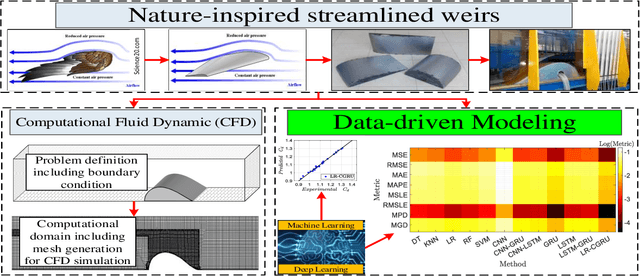
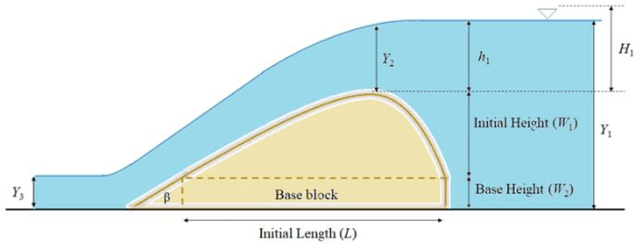
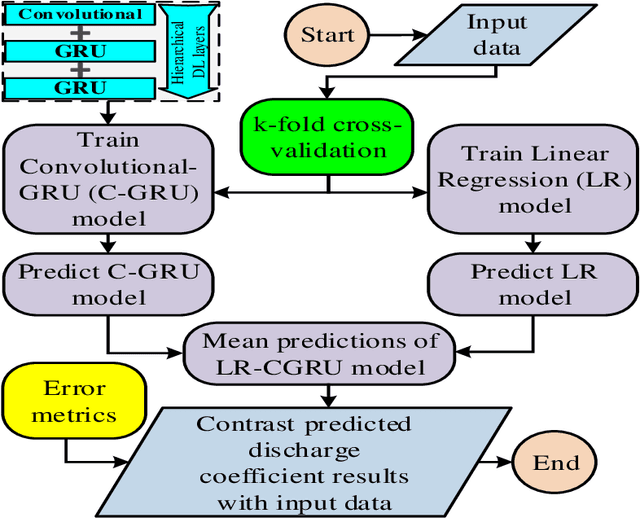
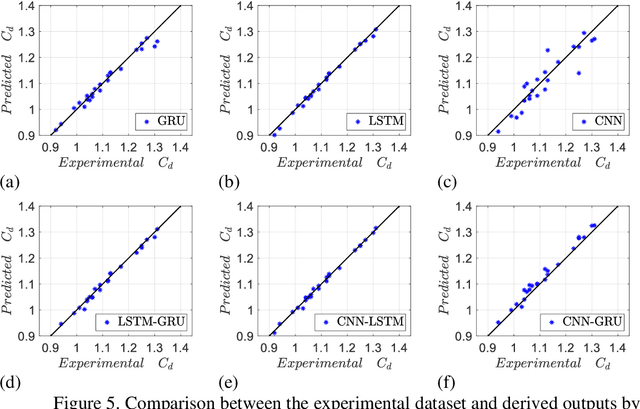
Abstract:Streamlined weirs which are a nature-inspired type of weir have gained tremendous attention among hydraulic engineers, mainly owing to their established performance with high discharge coefficients. Computational fluid dynamics (CFD) is considered as a robust tool to predict the discharge coefficient. To bypass the computational cost of CFD-based assessment, the present study proposes data-driven modeling techniques, as an alternative to CFD simulation, to predict the discharge coefficient based on an experimental dataset. To this end, after splitting the dataset using a k fold cross validation technique, the performance assessment of classical and hybrid machine learning deep learning (ML DL) algorithms is undertaken. Among ML techniques linear regression (LR) random forest (RF) support vector machine (SVM) k-nearest neighbor (KNN) and decision tree (DT) algorithms are studied. In the context of DL, long short-term memory (LSTM) convolutional neural network (CNN) and gated recurrent unit (GRU) and their hybrid forms such as LSTM GRU, CNN LSTM and CNN GRU techniques, are compared using different error metrics. It is found that the proposed three layer hierarchical DL algorithm consisting of a convolutional layer coupled with two subsequent GRU levels, which is also hybridized with the LR method, leads to lower error metrics. This paper paves the way for data-driven modeling of streamlined weirs.
* 28 pages, 7 figures
FCM-DNN: diagnosing coronary artery disease by deep accuracy Fuzzy C-Means clustering model
Feb 28, 2022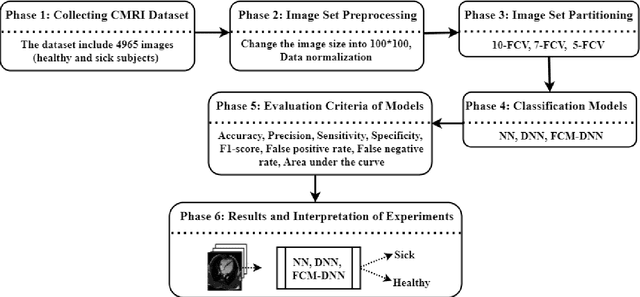

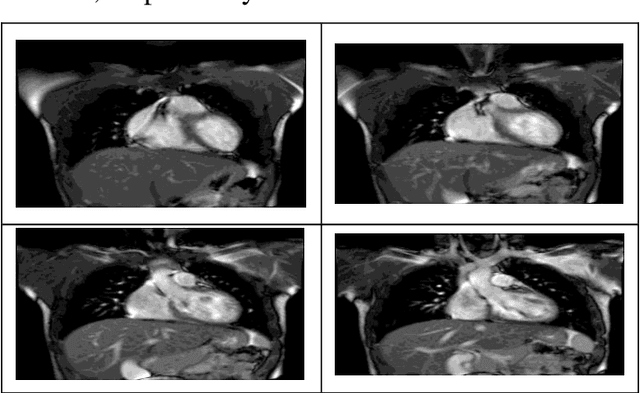

Abstract:Cardiovascular disease is one of the most challenging diseases in middle-aged and older people, which causes high mortality. Coronary artery disease (CAD) is known as a common cardiovascular disease. A standard clinical tool for diagnosing CAD is angiography. The main challenges are dangerous side effects and high angiography costs. Today, the development of artificial intelligence-based methods is a valuable achievement for diagnosing disease. Hence, in this paper, artificial intelligence methods such as neural network (NN), deep neural network (DNN), and Fuzzy C-Means clustering combined with deep neural network (FCM-DNN) are developed for diagnosing CAD on a cardiac magnetic resonance imaging (CMRI) dataset. The original dataset is used in two different approaches. First, the labeled dataset is applied to the NN and DNN to create the NN and DNN models. Second, the labels are removed, and the unlabeled dataset is clustered via the FCM method, and then, the clustered dataset is fed to the DNN to create the FCM-DNN model. By utilizing the second clustering and modeling, the training process is improved, and consequently, the accuracy is increased. As a result, the proposed FCM-DNN model achieves the best performance with a 99.91% accuracy specifying 10 clusters, i.e., 5 clusters for healthy subjects and 5 clusters for sick subjects, through the 10-fold cross-validation technique compared to the NN and DNN models reaching the accuracies of 92.18% and 99.63%, respectively. To the best of our knowledge, no study has been conducted for CAD diagnosis on the CMRI dataset using artificial intelligence methods. The results confirm that the proposed FCM-DNN model can be helpful for scientific and research centers.
A Survey of Applications of Artificial Intelligence for Myocardial Infarction Disease Diagnosis
Jul 05, 2021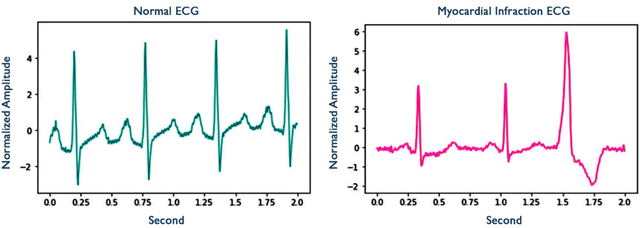


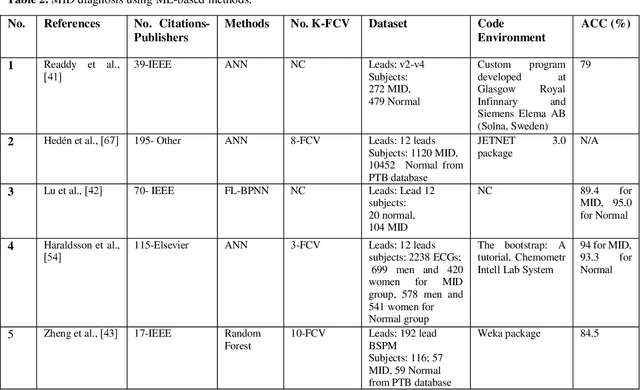
Abstract:Myocardial infarction disease (MID) is caused to the rapid progress of undiagnosed coronary artery disease (CAD) that indicates the injury of a heart cell by decreasing the blood flow to the cardiac muscles. MID is the leading cause of death in middle-aged and elderly subjects all over the world. In general, raw Electrocardiogram (ECG) signals are tested for MID identification by clinicians that is exhausting, time-consuming, and expensive. Artificial intelligence-based methods are proposed to handle the problems to diagnose MID on the ECG signals automatically. Hence, in this survey paper, artificial intelligence-based methods, including machine learning and deep learning, are review for MID diagnosis on the ECG signals. Using the methods demonstrate that the feature extraction and selection of ECG signals required to be handcrafted in the ML methods. In contrast, these tasks are explored automatically in the DL methods. Based on our best knowledge, Deep Convolutional Neural Network (DCNN) methods are highly required methods developed for the early diagnosis of MID on the ECG signals. Most researchers have tended to use DCNN methods, and no studies have surveyed using artificial intelligence methods for MID diagnosis on the ECG signals.
Time Series Forecasting of New Cases and New Deaths Rate for COVID-19 using Deep Learning Methods
Apr 28, 2021



Abstract:Covid-19 has been started in the year 2019 and imposed restrictions in many countries and costs organisations and governments. Predicting the number of new cases and deaths during this period can be a useful step in predicting the costs and facilities required in the future. The purpose of this study is to predict new cases and death rate for seven days ahead. Deep learning methods and statistical analysis model these predictions for 100 days. Six different deep learning methods are examined for the data adopted from the WHO website. Three methods are known as LSTM, Convolutional LSTM, and GRU. The bi-directional mode is then considered for each method to forecast the rate of new cases and new deaths for Australia and Iran countries. This study is novel as it attempts to implement the mentioned three deep learning methods, along with their Bi-directional models, to predict COVID-19 new cases and new death rate time series. All methods are compared, and results are presented. The results are examined in the form of graphs and statistical analyses. The results show that the Bi-directional models have lower error than other models. Several error evaluation metrics are presented to compare all models, and finally, the superiority of Bi-directional methods are determined. The experimental results and statistical test show on datasets to compare the proposed method with other baseline methods. This research could be useful for organisations working against COVID-19 and determining their long-term plans.
CNN AE: Convolution Neural Network combined with Autoencoder approach to detect survival chance of COVID 19 patients
Apr 18, 2021



Abstract:In this paper, we propose a novel method named CNN-AE to predict survival chance of COVID-19 patients using a CNN trained on clinical information. To further increase the prediction accuracy, we use the CNN in combination with an autoencoder. Our method is one of the first that aims to predict survival chance of already infected patients. We rely on clinical data to carry out the prediction. The motivation is that the required resources to prepare CT images are expensive and limited compared to the resources required to collect clinical data such as blood pressure, liver disease, etc. We evaluate our method on a publicly available clinical dataset of deceased and recovered patients which we have collected. Careful analysis of the dataset properties is also presented which consists of important features extraction and correlation computation between features. Since most of COVID-19 patients are usually recovered, the number of deceased samples of our dataset is low leading to data imbalance. To remedy this issue, a data augmentation procedure based on autoencoders is proposed. To demonstrate the generality of our augmentation method, we train random forest and Na\"ive Bayes on our dataset with and without augmentation and compare their performance. We also evaluate our method on another dataset for further generality verification. Experimental results reveal the superiority of CNN-AE method compared to the standard CNN as well as other methods such as random forest and Na\"ive Bayes. COVID-19 detection average accuracy of CNN-AE is 96.05% which is higher than CNN average accuracy of 92.49%. To show that clinical data can be used as a reliable dataset for COVID-19 survival chance prediction, CNN-AE is compared with a standard CNN which is trained on CT images.
Fusion of convolution neural network, support vector machine and Sobel filter for accurate detection of COVID-19 patients using X-ray images
Feb 13, 2021
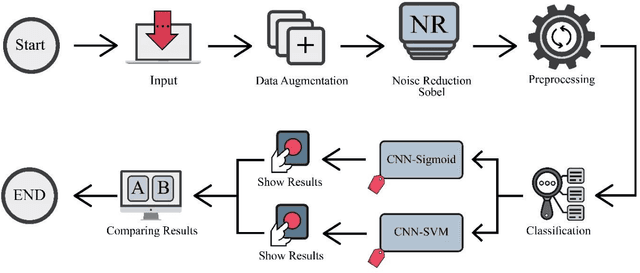

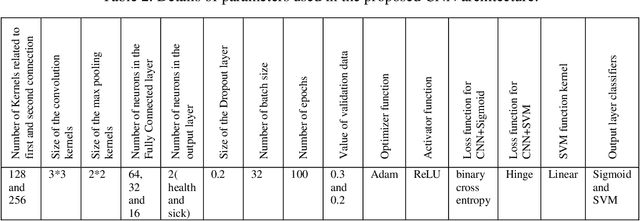
Abstract:The coronavirus (COVID-19) is currently the most common contagious disease which is prevalent all over the world. The main challenge of this disease is the primary diagnosis to prevent secondary infections and its spread from one person to another. Therefore, it is essential to use an automatic diagnosis system along with clinical procedures for the rapid diagnosis of COVID-19 to prevent its spread. Artificial intelligence techniques using computed tomography (CT) images of the lungs and chest radiography have the potential to obtain high diagnostic performance for Covid-19 diagnosis. In this study, a fusion of convolutional neural network (CNN), support vector machine (SVM), and Sobel filter is proposed to detect COVID-19 using X-ray images. A new X-ray image dataset was collected and subjected to high pass filter using a Sobel filter to obtain the edges of the images. Then these images are fed to CNN deep learning model followed by SVM classifier with ten-fold cross validation strategy. This method is designed so that it can learn with not many data. Our results show that the proposed CNN-SVM with Sobel filtering (CNN-SVM+Sobel) achieved the highest classification accuracy of 99.02% in accurate detection of COVID-19. It showed that using Sobel filter can improve the performance of CNN. Unlike most of the other researches, this method does not use a pre-trained network. We have also validated our developed model using six public databases and obtained the highest performance. Hence, our developed model is ready for clinical application
 Add to Chrome
Add to Chrome Add to Firefox
Add to Firefox Add to Edge
Add to Edge